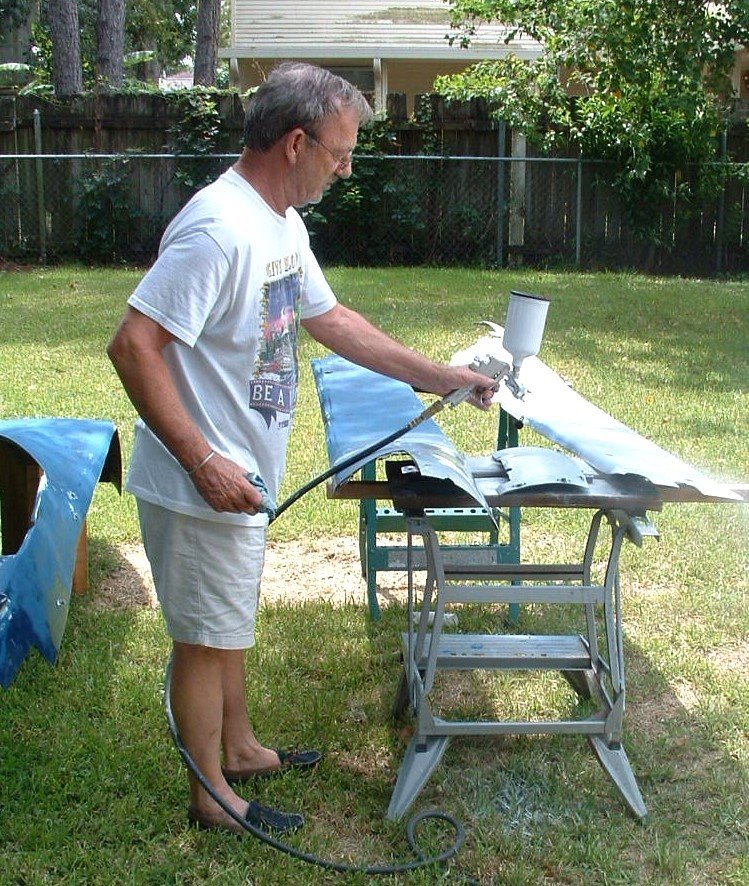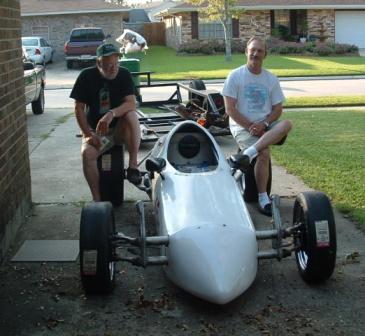
For the last week I have been waiting for parts to arrive. Parts for 1964 Volkswagen Bugs are not on your average AutoZone shelf anymore.
It has also rained every afternoon and that puts a damper on things. Rain makes for nice afternoon naps, but it also sends the humidity through the roof.
Since there was not much I could do with out the parts I wanted, I started working on the body. The body was the least of my concerns. All things considered the body was in fairly decent shape. For a twenty-year-old racer it was in great shape.
There were a few fiberglass repairs that needed to done, but relatively few.
Some past owner had cut the side body panels right at the line where the leading part of the trailing arm pivots from the frame. I suspect this was so the rear section, which covers the lower part of the engine, could be removed without having to undo the trailing arm.
Later, for some equally obscure reason, they had made an attempt to glass the pieces back together and had really botched the job. That all had to be broken away and redone properly. Not a difficult job, but time consuming and just the thing for a couple of rainy afternoons.
After I got these back together I put body filler on the outside face and smoothed over the area where it had been cut. I also cleaned up a lot of little nicks and gouges and sanded them smooth. Not perfect but better. Perfect bodies on race cars are only for Vintage show cars. They are meant to be seen more than driven.
There was a section on the right rear end of the body that had received some damage. This was glassed on the inside for strength, and body filler applied to the out side to cover up the cracks, sanded and made ready.

Hugh, having graduated from spray cans to a spray gun, pitched in and shot the three pieces with primer. For this we use our shade tree spray booth. The compressor for the spray gun scares the dogs and they stay inside. With our dogs that is an advantage. They think the perfect place to be is right where you are about to put your foot.
With the primer on and dry you could really see the ripples and defects in the bodywork. The biggest problem was the air scoops that force air over the oil cooler. These were badly damaged and in great need of repair. I aligned the broken pieces as well as I could and reinforced the backside with new fiberglass to give them some heft. When I was satisfied that they would not fly off, I started on the visible side.
Some people are just naturals at doing little things like this. I’m not one of them. I have to foul it up a few times before I get it right.
I had been having a problem with the body filler hardening before I could get it all in place. High temperatures and high humidity probably had something to do with that. So, smart rabbit that I am, I figured I would ease up on the amount of hardening stuff I mixed with the filler. This time I got all in place before it began to set. It was late in the afternoon so I planned to let it harden over night and attack it in the morning.
It didn’t work that way. The next morning it was still soft and gummy. It was not setting up at all. I left it for another twenty-four hours and checked it again.
Now I was faced with the prospect of scraping all that crap off the body and doing it all over again with enough hardener to make it set up. Sometimes it seems like two steps back for every step forward.
That was the bad news.
The good news was that I got my numbers ordered. I was going with the number sixty-nine on the car and that would hold with tradition. My first Vee had been number forty-five because I was forty-five years old when I started racing it. I was sixty-nine when I started on this car. Sixty-nine seemed right. Besides, there was just something about that number I liked.
As part of the number package, I was getting the eight inch high numbers for the sides and four inch class designators to go with them. There were also six inch numbers for the nose, and a two inch high drivers name tag for each side, To that I added a couple of other little goodies.

I sent them the camera-ready artwork for the Blind Mule Logo that appears on the banner at the top of this page and the Grinch logo.
I was planning to place the blind mule logo one each side just under the drivers name and the four inch high Grinch on the nose, just under the front numbers.
The side panels of the car would be a glossy black. The top section however was going to be a silver gray. The side numbers would be silver to match the top. The front number, the driver’s name and the logos would all be black to show up against the silver. This combo would be set off with bright red pen stripping. I hoped it would look as good in three dimensions and it did in my mind.
It wouldn’t make it any faster, but it would make me feel better.



 s with it……yet.
s with it……yet.











